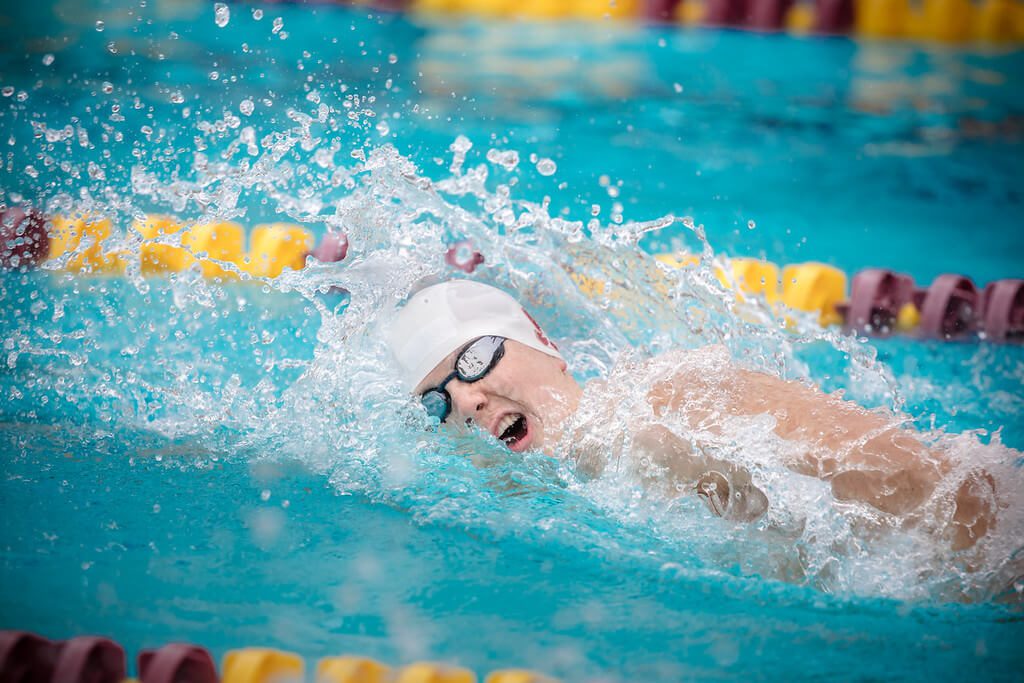International Experience in Hand, True Sweetser Ready for First College Championships

By David Rieder.
In his very first swim at the Olympic Trials, True Sweetser swam a best time to qualify for the final of the men’s 400 free. From there, the meet was anything but a smooth ride.
Competing for Gator Swim Club, Sweetser placed sixth in prelims with a 3:48.20. But that evening, when he walked out for the final to blaring music and a raucous crowd at the CenturyLink Center, Sweetser was suddenly out of his element.
“I got a little bit rattled,” Sweetser said. “The field went out very fast—obviously Clark Smith was a second under world record-pace at the 200—and [future Stanford teammate] Grant [Shoults] and I were next to each other in seven and eight, and we were quite far behind.”
Sweetser ended up finishing in 3:50.71, good for sixth place but five seconds behind fifth. The next morning, he swam a best time in the 200 free, finishing 28th in 1:49.59, but a few days later in the 1500 free, the event he considered his best, Sweetser added 14 seconds to his best time. Finishing in 15:24.68, he finished 14th and nowhere close to qualifying for the final.
“I think it was a combination of going out a little too hard as well not being mentally prepared for what I would have to do in the preliminaries to guarantee myself a spot in the final. That was the worst swim of my career, for sure,” he said.
But a little over a month later, Sweetser managed to put a nice cap on his prep swimming career at the U.S. Open in Minneapolis, finishing third in the 400 free in 3:47.92 and second in the 1500 in 15:04.52. Both were best times, and the mile ranked him third in the country for 2016, good enough to earn a spot on the U.S. National Team.
And then it was time for Sweetser to uproot his life and move across the country, from Gainesville, Fla., to Palo Alto, Calif.
“Gainesville is a small town—50,000 people, and that includes the University of Florida,” he said. “Without the University, it’d be a real small town in country-Florida, not beach-Florida. It’s a little bit of a switch.”
On the west coast, Sweetser has found a more temperate climate, challenging academics (he is at Stanford, after all) and one of the premier distance training groups in the country. Junior Liam Egan, who finished 14th in the mile at NCAAs last season, has become something of a personal training partner for Sweetser, while Shoults splits time with the distance and mid-distance groups.
The trio swims under the guidance of Stanford assistant coach Jeff Kostoff, who came over from Indiana before the season when Scott Armstrong left to take over the head job at Johns Hopkins. Kostoff, of course, was a Stanford alum and two-time U.S. Olympian that held the National High School record in the 500 free for 30 years.
“I was so ecstatic to hear when Jeff got the new position,” Sweetser said. “I remember being back in middle school and reading a Swimming World article about Jeff Kostoff and not only his practice exploits but also his perspective to racing. I was just thinking, ‘what a cool guy, what a legend!’”
Kostoff’s three best 500 freestylers got to show off their mettle at the Texas Invite in December, and all three went under the previous Stanford school record of 4:13.07. Shoults finished atop the trio in 4:12.03, followed by Sweetser (4:12.97) and Egan (4:12.99).
“It’s a little bit of déjà vu,” Sweetser said, “because I look over and see Liam swimming there and his stroke technique, which is burned into my mind. It’s a pretty cool feeling.”
Later on at that meet, Sweetser swam the 1650 free against Texas senior Clark Smith—the same man who left Sweetser in his wake when the two swam in the 400 free final together at Olympic Trials.
In their mile showdown in Austin, Smith jumped out to an early lead, but Sweetser showed some grit, taking over the lead at the 300-yard mark and extending his lead to more than a second.
Smith would end up battling back and winning the race by more than two seconds, but Sweetser posted a time of 14:35.03, a best time by some 13 seconds and the No. 2 time in the country to that point in the season.
But the perfectionist that he is, Sweetser couldn’t get too excited about his performance.
“I was obviously a little disappointed in the placing,” he said. “It was an interesting race because I don’t normally go out that fast when I swim my best races, and I think my splits for the 500s were 4:23, 4:25, 4:27. Normally it would be in the opposite direction or at least, 4:23, 4:25, 4:25.”
Not that he had too long to spend thinking about that mile—the next day, he hopped on a plane to Detroit, a 19-year-old bound for his first senior-level international competition. He was slated to compete in the 1500 free at the Short Course World Championships in Windsor.
Sweetser spent much of his time in Canada in his hotel room with Stanford teammate Abrahm Devine taking care of missed school work and preparing for final exams—Sweetser actually had to take two finals within his first 48 hours back in California—but in the pool, there was business to attend to.
Specifically, Sweetser had his sights set on earning a spot in the championship final.
“Going into the preliminaries, I was looking at the heat sheets, and I was stressed because I’m out in lane seven and I’m not even one of the fastest guys in the heat,” he said. “Then I looked at the heat sheet again, and I was like, ‘But Gabriele Detti is in lane four. That guy got the bronze at the Olympics in the 400 and the mile. How cool is it to just race him!’”
Sweetser finished second in his heat in 14:34.05—six one-hundredths ahead of Detti—and qualified sixth out of prelims. He held that position in the final, even though he ended up swimming about one second slower.
“It was awesome—literally the best experience of my life,” he said. “I plugged [my time] into several time converters, and they were all sub-15:00 long course. So I probably went a best time, so that’s good.”
Even though his efforts in the 400-meter and 500-yard races have been consistent, Sweetser knows that his distance background is primarily suited for the mile. But after his “horribly disappointing” swim at Olympic Trials, Sweetser admits that it took some time to build back up his confidence for the event.
“My mile is still a bit tentative. I swam well in that event at U.S. Open a month [after Trials], but I realized, ‘Wow, I can really blow up in that event if I’m not completely ready to go,” he said.
Sweetser still believes that he can squeeze more out of his body position and catch, particularly after Kostoff pointed out that he took more strokes per length than anyone else in the Windsor final.
But as much as the mental aspect and the technical details can help Sweetser improve, he knows that it will take plenty of old-fashioned hard work to take him to the next level.
Shortly after Trials, Sweetser read up on Grant Hackett, the Aussie who won Olympic gold in the 1500 free in both 2000 and 2004 and remains the third-fastest performer of all-time in the event. He took Hackett’s words to heart.
“The reason he knew he could beat anyone in the mile was because every time he went behind the blocks, he knew that he had done more work than anyone else in that heat,” Sweetser said. “I think that whenever I go into a big mile or any mile at all, being confident in the work I put in, no matter how I feel, I can swim fast.”
Sweetser’s international debut in Windsor gave him a taste of just how a World Championships operates and what it will take to be competitive with the top milers in the world. But before he gets another shot at that level this summer, he has an NCAA season to attend to.
He has time goals for both the college season or for this summer at World Championship Trials, but instead of harping over those, Sweetser forces himself to focus on the only aspects of his race that he can control—not his place or even the clock, but effort and execution.
“What it will take for me to be satisfied with my performances is just to have swum the race that I knew was my personal best effort and the best that I can do,” he said.
“Because if I do that, whatever time I get, whatever place I get won’t matter very much in the grand scheme because I gave all I had, prepared the best I could and gave my best effort on the day.”
And with the mile set to be wide open for the taking at both the NCAA championships and, with Connor Jaeger now retired, at World Championship Trials, Sweetser’s efforts might just end up translating into tangible results before he reaches his 20th birthday.
To read more about Sweetser, Katrina Konopka, Ella Eastin, Michael Chadwick and Mallory Comerford—all rookies on the U.S. Short Course World Championships team—check out “An Opportunity of a Lifetime” in the February issue of Swimming World Magazine. All commentaries are the opinion of the author and do not necessarily reflect the views of Swimming World Magazine nor its staff.





True, you have a good focus.
The Pac 12 is right now, then on to the next one.
You study your competitors, very smart like in any other sport!
Great coaching, excellent pool/training partners.